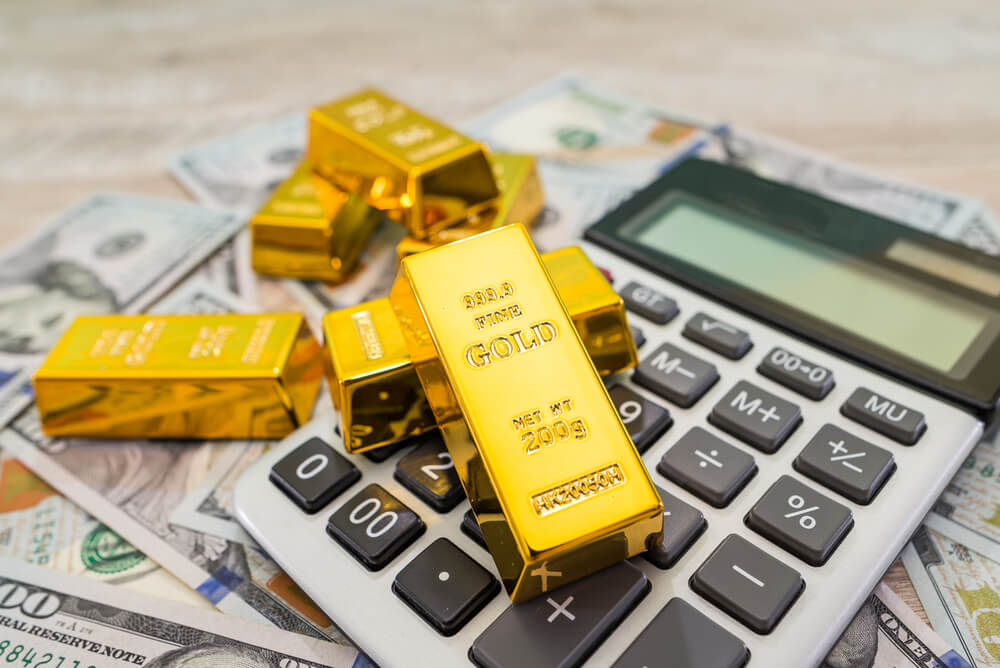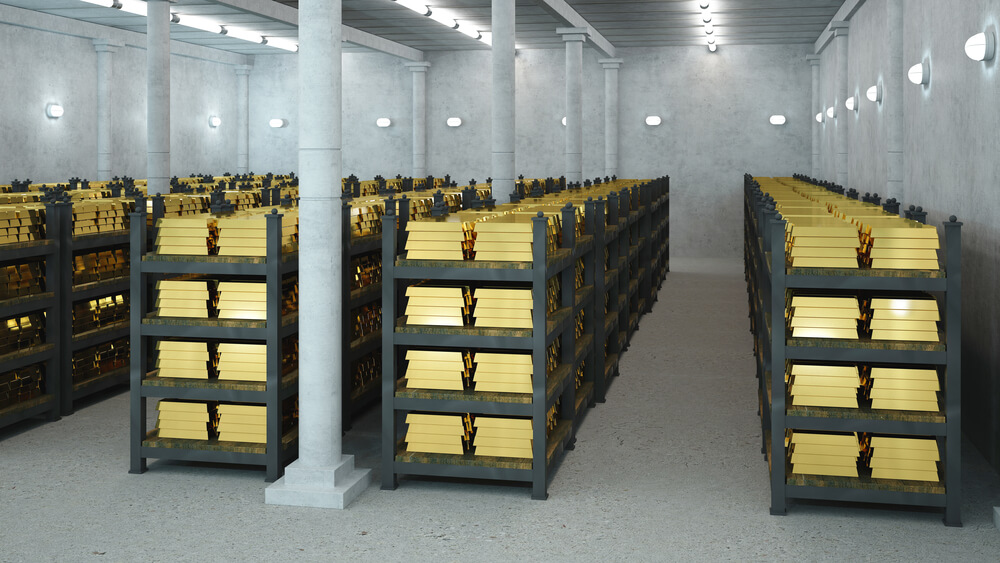
Top 10 Countries with the Highest Gold Reserves
Although the gold standard is long abandoned, gold continues to be dear for countries and individuals alike. A nation’s gold reserve is a key component or indicator of its financial and economic stability. In other words, gold influences exchange rates and currencies. It’s, therefore, not surprising that major economies continue to hold on to a significant portion of gold in their vaults.

Since gold is precious in different ways and gold investing steadily rise when the markets are starting to look bad, we were curious enough to learn about the countries with the most extensive official hoards, and therefore, this comprehensive piece. To throw light, this article will discuss the following:
- A brief introduction to the term “gold reserve.”
- The reasons to stock gold as a country
- The top 10 countries with the most gold in their kitty globally
- Answers to some pertinent questions and more
Read on to learn more about gold reserves, the countries with the biggest gold hauls, and possibly gain an understanding of a state’s economic stability, geopolitical influence, etc., in relation to its gold holdings.
Table of Contents
What is a Gold Reserve?
The meaning of “gold reserve” is stored gold, usually in a safe and secure place. In a country’s context, the term denotes the amount of physical gold a nation has in its primary bank or the well-guarded vaults managed by the bank or an equivalent government agency. During the gold standard, the gold store helped support national currencies. However, in the post-gold standard era, gold holdings safeguard against economic uncertainties, dwindling currency value, etc.
The gold procured could be courtesy of domestic production or a result of the gold-purchasing activity of the concerned government or the country’s central bank. Some countries could have accumulated gold historically and maintained those holdings over time. Several centuries ago, when wars weren’t rare, a fallen country’s gold reserve was viewed as a reward or prize for the war victor.
By the way, a terminology commonly used in the same breath as gold holdings is “repatriation.” Gold repatriation is a country moving its foreign-stored gold to its soil. Several countries use foreign vaults to keep some of their gold assets safely. In the past, countries transferred gold to foreign locations to not lose all their gold to a successful invasion. In current times, a significant portion of a country’s gold is usually vaulted locally.
Read more: What Happens to Gold When the Stock Market Crashes?
The Significance of Gold Reserves
A gold reservoir affects a currency’s value. It lays the foundation for a nation’s currency. Although no country’s currency is gold-backed anymore, a looming fear of global economic instability nudges countries to always keep an inherently valuable commodity like gold in store. Gold owned and stored in vaults provide financial stability due to its tendency to remain relatively stable over time.
Gold reserves foster collaboration between central banks of different countries or via the IMF (International Monetary Fund) and other similar institutions. Governments can use their gold reserves during a global financial crisis to boost stability. If a particular apex bank has temporary financial troubles, the central banks with surfeit gold can lend much-needed liquidity.
Gold in the kitty could also reflect a country’s history, identity, and heritage. It may emphasize the role or significance of gold in the country’s past or symbolize the nation's wealth and power. The reserves could remind others of the land’s past economic conquests, triumphs, trade relationships, etc. Central banks of the world actively increase their gold holdings to diversify their assets in reserve and mitigate credit currency risks.
Countries with the Most Gold Reserves
The world has more than 208,800 tons of already-mined gold. The 50th country on the list of the largest gold reserves in the world by a country is Bolivia, with around 42.5 tons of gold in its reserve. Anyway, here is the list of countries with the most gold holdings.

1. United States of America (8,133 tons)
America is the world’s largest economy. Unsurprisingly, it also has the world’s largest official holdings of gold, with 8,133 tons of gold in its bag. America has nearly as much gold as the gold of the three countries combined. America embraced the gold standard during the 19th century. And the 1934 Gold Reserve Act contributed heavily to the federal government owning the majority of gold worldwide.
The fiat currency system was adopted when President Nixon ended the gold standard era in 1971. But that did not conclude the strategic and symbolic part gold holdings played in the American monetary policy. The United States’ gold holdings doubled between 1900 and 1913. It doubled again between 1913 and 1933. Between 1933 and 1941, there was a fourfold increase, mainly attributed to foreign investment and the state’s decision to ban individuals from owning gold.
The reserves were halved by 1970. That was when talks of abandoning the gold standard were in full flow, and American citizens were permitted to own gold again. Currently, America holds a significant portion of its precious metal reserves at Kentucky’s Fort Knox, besides several other locations. More than 75% of America’s foreign reserves are gold. Any significant changes in the country’s gold holdings could indicate seismic changes in economic priorities and impact financial markets worldwide.
2. Germany (3,355 tons)
Germany’s modern inclination toward gold and stockpiling of the precious metal began after the Second World War. After the war, the country’s economy was in shambles. The Marshall Plan (the European Recovery Program) was instituted to rebuild the economy. The America-sponsored program was created to restore the economies of several southern and western European nations and sustain democracy in the region after World War II. A portion of the funds received was put into gold, laying the base for Germany’s gold holdings.
Germany prioritizes economic stability, and its yellow metal accounts defend against financial uncertainties like currency volatility. The country's central bank, the Bundesbank, had held charge of Germany’s gold since 1951 when the government started accumulating gold. Gold in the country's foreign reserves helps maintain the euro’s value. It assists in managing exchange rates. It’s worth mentioning that Germany has had a relatively minor dip in the amount of gold in its reserves between 2000 and 2022.
Germany stores its gold in primarily three places: Frankfurt am Main’s Deutsche Bundesbank, the New York branch of the U.S. Federal Reserve Bank, and London’s Bank of England. The Bank of England is the global gold trading center. On the other hand, the New York Federal Reserve Bank branch houses the biggest pile of gold globally.
It’s worth mentioning that Germany’s central bank fairly recently repatriated a significant chunk of its gold stored in the N.Y. Federal Reserve Bank and Paris’ Banque de France to Bundesbank’s Frankfurt headquarters in 2013. The shift in location was believed to help rescue the troubled finances of other European countries and back the Deutsche Mark if the eurozone collapsed.
Germany did not initially move the gold from its soil to New York. It acquired the gold from the U.S. due to trade surpluses with America before the 1970s. The gold was not shifted to Germany then, fearing a Soviet Union invasion. Frankfurt was only around 100 kilometers (approx. 62 miles) away from the Soviet-controlled East Germany border.
Decades later, the repatriation process began after the looming threat had long gone. In 2013, only five tons were moved due to logistical concerns. In 2014, 120 tons of gold were repatriated from New York (85 tons) and Paris (35 tons). An additional 210 tons of gold were repatriated in 2015 from Paris (110.5 tons) and New York (99.5 tons). In 2016, a total of 200 tons of gold were shifted.
3. Italy (2,451 tons)
Italy has the third-highest gold allocation. The nation’s desire or penchant to stockpile gold has economic, cultural, and artistic reasons. Moreover, Italy’s positioning as a leading trading and economic force in the Mediterranean zone played a part in its gathering of gold over the centuries. Itay’s history of high inflation periods and other economic uncertainties has stressed the need for stable gold reserves.
Banca d’Italia, Italy’s central bank, manages the nation’s gold holdings, focusing on monetary policy and financial stability. In 1893, when the foundation stone for the bank was laid, Italy started to build on its gold resources. Most of Italy’s existing gold holdings are from the accumulation after the Second World War.
From the 1950s to the 1960s, Italy experienced robust industrial and economic growth. The central bank’s administrators then employed a savings policy that invested in gold since it was viewed as a safe asset. Italy’s lira was a relatively weak currency (part a deliberate ploy and part natural). The bank’s authorities, therefore, considered it wiser to build a reserve of gold as a value guarantee.
4. France (2,437 tons)
Three of the top four countries with the most gold holdings are European. And that’s not incidental. Europe has a history of prioritizing precious metals as a “value store,” thanks to the continent’s turbulent ancient past. France is fourth on the list, despite not having a single gold mine on its soil. France has always been a global power. And thanks to its colonial endeavors, particularly in gold resources-rich regions, the country has accumulated significant gold over periods.
The Montagne d’Or mine (Mountain of Gold) is France’s biggest gold mining project in French Guiana. Mali, an erstwhile colony of France, has more than 850 gold mines. France moved gold from these places and engaged in trading, allowing the yellow metal to flow effortlessly from the colonies to its soil. Also, France’s economic policies over the years have favored the accumulation of gold. Sound trade policies, fiscal management, efforts to sustain its currency value, etc., gradually increased its gold trade and reserves.
Paris, France’s capital, has always been a major global financial hub. Facilitating and engaging with the worldwide investing, trading, and economic communities let France draw and handle gold assets from across the globe. Not to mention, the French franc was once a reserve currency for the world. France, therefore, held and managed significant gold holdings to maintain the currency’s status and support economic stability.
5. Russia (2,299 tons)
Russia has the fifth largest reserves of gold in the world. In 2017 and before, China was number 5. It overtook China in 2018 in the gold holdings by country list. Russia wanted to spread its American investments, and buying gold was one way. The Russian central bank bought bullion primarily by selling U.S. Treasury bonds.
Russian inclination toward gold holdings goes back to the country’s imperial periods when it accumulated a significant chunk of gold. Geopolitical shifts and economic reforms had a bearing on the gold reserves. In recent times, particularly after the multiple sanctions imposed by the West, Russia’s drive to stock gold is at its highest, accommodating the country’s more significant geopolitical and economic strategies.
According to Russian media, the country has the fourth biggest gold holdings in the world. But let's not read into the report much since Russian media is infamous for bias and being unabashedly pro-Russia. We’ll update our list when more reliable and mainstream media outlets pick up and ratify the story.
6. China (1,948 tons)
China is the world’s second-biggest economy. Consequently, interest in details about the Asian giant’s gold holdings is high. Surprisingly, the country is sixth on the list, despite having a much bigger landmass and more than 125 goldmines. The five biggest gold mines are in China. Not to mention, China is also one of the leading gold producers in the world.
Local consumption is the biggest reason China has relatively fewer gold holdings. Although the country exports some of its gold, the number is negligible compared to its domestic demand. China uses more gold than it makes. That means a significant part of the gold mined could be used to meet the retail demand than boosting the country’s official gold holdings.
China became sixth in the world’s largest gold reserves in 2011. Between 2009 and 2015, China had a nearly 60% climb in its reserves. It was 1,054 tons and 1,658 tons of gold in 2009 and 2015, respectively. Fast-forward to 2023, the People’s Bank of China was the second biggest buyer of gold among central banks keen on increasing their official reserves. China is not as transparent or forthcoming about the gold in its kitty. Therefore, it could likely have more gold than it claims, or the tally may have considerably increased.
The increasing interest in buying gold and diversifying reserves could be an attempt to spread the assets and rely less on the U.S. dollar. Gold is usually picked up when international markets are in turmoil and a global economic recession threat looms. China’s inclination to buy more gold is a consequence of multiple factors.
7. Switzerland (1,040 tons)
Although a relatively smaller country, Switzerland plays a critical role in the global economy, reflecting its gold holdings status. Switzerland has been collecting gold for centuries. The country’s positioning as a “haven” or its financial hub status has all lent to the buildup of its gold holdings. Also, the Swiss Franc was gold-backed in the past, further underlining gold’s importance in the country’s monetary history.
The SNB (Swiss National Bank) is committed to the country’s financial stability, and holding gold is a way to safeguard the economy against economic crises and protect the national currency’s value. The apex bank controls the precious metal as an aspect of its reserve management strategy. The proper management of the gold holdings signals the nation’s financial prudence and fiscal responsibility.
By the way, Switzerland’s gold trading and refining industry is quite robust. It’s a key player in the world gold supply chain, refining and processing gold procured from different sources across the globe. The country’s well-established reputation for financial reliability and expertise has helped fuel demand and attract gold assets from across the globe.
8. Japan (846 tons)
Like most countries with a substantial chunk of gold in their official lockers, Japan’s fascination for gold skyrocketed after the Second World War. That said, the country’s love for gold is several centuries old. Gold has economic, cultural, and ceremonial significance in Japan despite the country not being a foremost producer of gold. Japan’s economic growth, technological advancements, exports, etc., lend to its capability to amass these reserves.
After the Second World War, Japan underwent a phase of rebuilding and economic development. The focus was on stabilizing its economy and currency, prompting Japan to hold gold and other assets in its foreign exchange reserves. The measures helped or accelerated the country’s post-war recovery. The Bank of Japan, the country’s central bank, manages the gold resources, maintaining financial stability and supporting monetary policy.
9. India (795 tons)
The second most populated country in the world and the fifth largest economy in the world, India was bound to be on this list. The South Asian country is also the largest consumer of gold. Although India’s tally of 795 tons is not something to write home about, it is the only country to feature from the Indian subcontinent, home to more than 1.7 billion people. It’s no revelation that India and its mighty neighbor China love their gold, and the central banks of the respective countries having some gold in their vaults is only natural.
The RBI (Reserve Bank of India) manages the country’s gold holdings. The central bank’s gold reserves are part of the country’s foreign exchange reserves. The gold holdings are critical to India’s reserve management strategy, supporting monetary policy objectives and currency stability.
10. Netherlands (612 tons)
The Netherlands is the sixth European country to feature on this “top 10 countries with most gold reserves” list. Also, it is not a major gold producer. The nation has always been a major global trading and economic power. During the Dutch Golden Age in the 17th century, Netherlands’ financial markets, maritime trade, colonial ventures, etc., thrived and contributed majorly to wealth accumulation, which included gold.
In 2014, the Dutch central bank announced its decision to move some of its gold stored in the N.Y. Federal Reserve’s, reducing it to 31% from 51%. The De Nederlandsche Bank’s objective behind the move was to keep as much gold as possible nearby to tackle financial crises and similar economic climates more adroitly. Close to 122.5 tons were repatriated from New York to Amsterdam. The Netherlands has gold in foreign locations like New York, London, and Ottawa.
Gold Holdings Spread
Not all gold belonging to a country is stored in its principal bank or a single chain or network of banks. Although a country’s central bank’s portfolio consists of most gold, significant other portions are stored elsewhere. The following is a general breakdown of how and where the gold that directly or indirectly belongs to a country is stored.
Official Reserves
As stated earlier, the gold standard doesn’t exist anymore. But countries choose to keep stock of the precious yellow metal just in case or to ensure their currencies’ stability. The gold is held with the central bank. A country’s official gold holdings play a major role in determining its monetary policy, besides safeguarding against economic uncertainties and paper money fluctuations.
Foreign Reserves
Countries usually choose to keep gold in foreign countries citing burdensome security measures. Maybe the home country needs more infrastructure to safely store and guard its gold, or the gold stockpile overflows existing storage spaces. Or, the geographical location could be more vulnerable to natural disasters, potentially wreaking havoc on the stored gold.
Usually, a significant chunk is stored offshore, which helps support global trade, ensure a nation’s capability to meet external commitments and stabilize exchange rates. The reserved gold represents economic strength, boosts diplomatic negotiations, and indicates stability to global partners.
Based on how robust the domestic and international banks are and their storage arrangements, only a small percentage or a bigger share of the gold could be stored in another country. A foreign storage facility is chosen after much thought and deliberation. Generally, the vault is established, reputed, and meets specific essential criteria. The place must be cost-efficient, can liquidate the reserves quickly or at short notice, and be highly secure.
National Sovereign Wealth Funds
Countries can also own or manage physical gold through a sovereign wealth fund (SWF). SWFs can be invested in different assets, such as gold, helping create income for the fund holder—in this case, the country. Gold’s allocation within an SWF could vary based on the fund’s strategy and the state’s economic primacies. If gold demand fell, the makeup of the fund will change accordingly.
Read more: Is Platinum More Valuable Than Gold?
Conclusion
A country’s gold cache is more than a sign of its financial health or preparedness to tackle future economic uncertainties. It also provides more than just a glimpse of the country’s past and the various things it was up to. The countries in the above list have a history of invasion or were significant economic powers for centuries.
India has not committed incursions into other countries' borders in the past and is, therefore, an anomaly. Switzerland is another neutral country that has been very confrontation-averse for decades or has had no instance of invading another region, at least not since the 1815 Treaty of Paris.
Undoubtedly, gold has transcended as a sign of wealth, cultural heritage, and financial stability. On a macro level, the precious metal is a cornerstone of international diplomacy and economic policy. It’s unsurprising to see countries or their central banks trying to amass their gold holdings and not liquidating them too much, even when in dire straits.
If your country made the list, congratulations. But if it didn’t, find where it features outside the top 10 list and its chances of making it inside the top 10 or coming nearer to it. As already stated, a healthy gold hoard is a sign of economic stability. You don’t want your homeland or country you live in as a citizen to trail too far behind.
FAQs
Why is the United Kingdom not on the list of countries with the most gold in its reserves?
The United Kingdom is the sixth biggest economy in the world. However, its gold reserves do not reflect that, with the country ranking a distant 17th globally. That’s primarily because the U.K. sold most of its gold holdings from 1999 to 2002 when gold global demand fell. The move was implemented to diversify U.K.’s assets away from gold and adopt a more diversified and flexible approach toward its monetary policy. Close to 50% of the gold was sold at prices lowest in the two decades prior. The proceeds were reinvested in euros and other foreign currencies.
How are a nation’s gold reserves measured?
The respective countries keep stock of the gold in their vaults and publish it to the public. The central banks offer the numbers in their reserve management reports or financial statements and dispense the info through official reports, publications, and websites. Besides, several third-party institutions and organizations, such as the IMF (International Monetary Fund) and WGC (World Gold Council), track the biggest gold holdings worldwide.
How much gold does the International Monetary Fund have in its reserves?
The IMF has more gold than Italy but not as much as Germany. If featured in the list above, it would rank third with its 2,815 tons of gold holdings at multiple designated depositories. That number has been relatively the same since 2011. The IMF’s gold reserves help the organization manage its activities.
IMF gets most of its gold from member countries which must contribute a specific quantity of their gold and currency to the entity. The IMF uses the gold and funds to help member nations in need. That is unlike sovereign nations using their gold reserves to support their monetary policies, stabilize their currencies, facilitate their global trade, etc.
What is the form of gold stored in a country’s gold reserve?
The gold stored in the official gold pool of a nation is usually in the bullion bar (physical gold) form minted by accredited refineries. The bars are pure and large enough to accumulate tons of gold quickly. Their storage-friendly or uniform designs make them convenient for storage and shipping.
Are private holdings of gold accounted for in a country’s gold reserve?
No, private ownership of gold doesn’t belong to the government and is, therefore, not included in the national reserve. A “private holding” of gold is owned by individuals, financial institutions, corporations, and any other entity not directly or indirectly related to or working for the government. Private gold is usually gold coins, jewelry, bullion bars, etc.
Private entities hold gold for various reasons, including cultural, investment, or wealth preservation. The gold held helps leverage and diversify an investment portfolio. Needless to say, private holdings of gold are separate from a country’s gold reserve.


